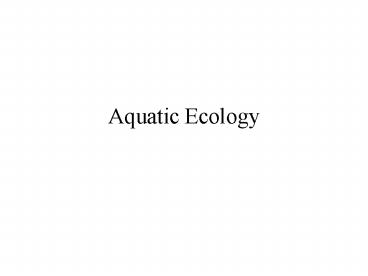Aquatic Ecology - PowerPoint PPT Presentation
1 / 31
Title:
Aquatic Ecology
Description:
lentic - swamps, bogs, marshes, lakes, ponds - standing water ... waterfowl & shorebird breeding areas. Mangrove swamps. Areas where salt tolerant trees live ... – PowerPoint PPT presentation
Number of Views:42
Avg rating:3.0/5.0
Title: Aquatic Ecology
1
Aquatic Ecology
2
Two Aquatic Life Zones
- Salt Water or Marine
- Freshwater
3
Marine
- Estuaries
- marshes
- bogs
- swamps
- Coastline
- coral reefs
- continental shelf
- Open ocean
4
Freshwater
- Surface water
- lentic - swamps, bogs, marshes, lakes, ponds -
standing water - lotic - streams, rivers and creeks - flowing
water - Wetlands
- Groundwater
- aquifers
- underground lakes
5
Aquatic Environments
- Light
- Euphotic zone zone of photosynthetic limitation
- Heat surface, middle and bottom layers
- Dissolved gasses
- Oxygen atmospheric and plant inputs unlike
atmosphere varies widely in aquatic ecosystems - CO2 atmospheric and animal inputs buffering
of atmosphere and changes in aquatic ecosystems - Nutrients
- Availability with depth and water conditions
6
Aquatic Organisms
- Plankton free floating animals and plants
- Phytoplankton plant plankton
- Zooplankton animal plankton feeding on
phytoplankton
7
Aquatic Organisms
- Nekton strong swimming consumer organisms
- Fish
- Turtles
- Whales
8
Aquatic Organisms
- Benthos bottom dwelling organisms
- oysters
- lobsters
- worms
9
Saltwater
- Oceans cover 71 of earths surface
- Regulation of climate
- Stores of Carbon Dioxide and production of Oxygen
- 250,000 species of organisms
10
Life zones of the Ocean
- zones defined by amount of solar radiation
penetrating the water - zones (in order of declining solar radiation)
- Coastal Zone
- Open Sea
- euphotic zone
- bathyl zone
- abyssal zone
11
Coastal Zone
- extends from hightide mark to edge of
continental shelf - entirely within the euphotic zone includes
estuaries, wetlands, barrier islands, coral
reefs - nutrientrich the site of most commercial
fisheries - high primary productivity sunlight nutrients
from land ocean currents
12
Euphotic Zone
- Euphotic zone the first 150m down
13
Bathyl zone
- Extends down from 1000m to 4000m,
- The only light is from bioluminescent organisms
- The only food is what trickles down from above,
or from eating other animals.
14
Abyssal Zone
- Abyssal Zone where the water is freezing and
there is no light this zone is an amazing 3000 to
11000m deep.
15
Estuaries and coastal wetlands
- Where freshwater meets saltwater
- Very productive essential nursery grounds
- Filters pollutants and impurities
- Breeding grounds for waterfowl and wildlife
16
Estuaries Coastal Wetlands
- nutrient rich
- high primary productivity
- nurseries for fish other aquatic animals
- waterfowl shorebird breeding areas
17
Mangrove swamps
- Areas where salt tolerant trees live
- Protective qualities against hurricanes
18
Coral Reefs
- high biodiversity like tropical rain forests of
the ocean - protect coastlines from storms high waves
- nurseries for many fish species
- disappearing
19
Rocky and sandy shores
- Intertidal zone area of life between low and
high tide - Niches for life in harsh changing environment
sand on beaches and rocks on rocky shores - Sand dunes protection against storms
20
Open Ocean
- Euphotic zone most productive
- 90 of water surface but 10 of fish
- Specialized organisms near vents
21
Human impacts
- Development along coast
- 3.9 billion people live along or near the coast
- Earth has lost 50 of coastal wetlands , US has
lost 55 - 37 of coastal fisheries closed due to pollution
- 10 of coral reefs lost, 30 in critical
condition and about 30 stable - Over 50 mangrove forests lost
22
Barrier Islands
- protect mainland from offshore storms
- shelter inland bays, estuaries, wetlands
- popular recreational residential areas
23
Freshwater
- Dissolved salt concentrations less than 1
- Covers 1 of earths surface
- 41 of fish species
24
Thermal Stratification of Lakes
- epilimnion warm, upper layer of water
- thermocline zone of lake where temperature
changes rapidly with depth - hypolimnion colder, denser lower layer of water
can be depleted of oxygen in eutrophic lakes
25
Overturn in Lakes
- upper layer of water sinks winds mix layers
- redistributes oxygen temperature evenly
- redistributes nutrients from the lower layers
- Dimictic
- Monomictic
- Polymictic
26
Oligotrophic Lakes
- Oligotrophic
- low nutrient supply
- low primary productivity
- clear water, few plants fish
27
Eutrophic Lake
- Eutrophic
- excess supply of nutrients
- high primary productivity
- murky water, large phytoplankton population
28
Stream Order
- Streams with no tributaries are 1st order
- Two first order streams joining form a 2nd order
stream, etc. - Entrance of smaller order tributaries does not
change the order of a stream
29
Streams
- Headwaters cold, well oxygenated waters with
trout, algae and mosses and macroinvertebrates - Transition warmer water with gentler slopes and
fewer obstacles increase of phytoplankton with
mixed warm and cool water fish - Flood plain deep rivers along flat broad
valleys. Similar makeup to lakes
30
Wetlands
- Where streams meet lakes
- Provides food and habitats for fish, waterfowl
and wildlife - Filter toxics from water
- Reduce flooding by releasing water slowly
- Replenish groundwater supplies
- Important for recreation and hunting
31
Human Impacts
- Dredging and filling of wetlands mitigation
banking of wetlands not net loss - Damming rivers
- Sedimentation
- Fish stocking and introductions zebra mussels































